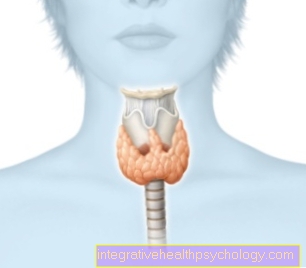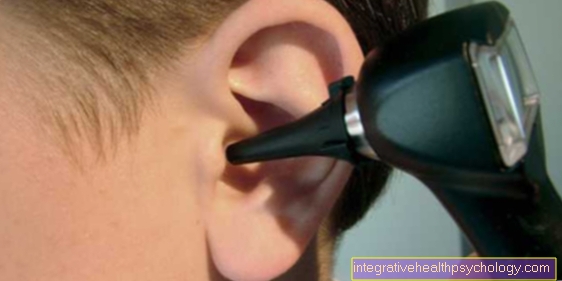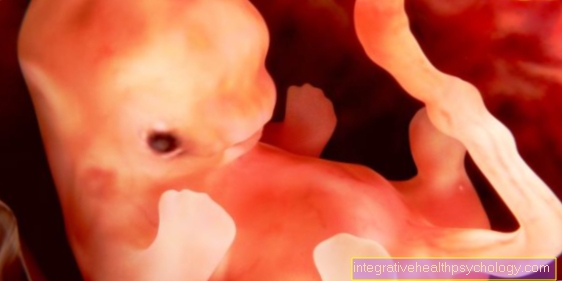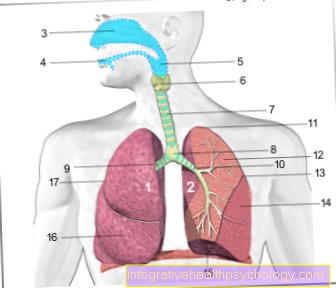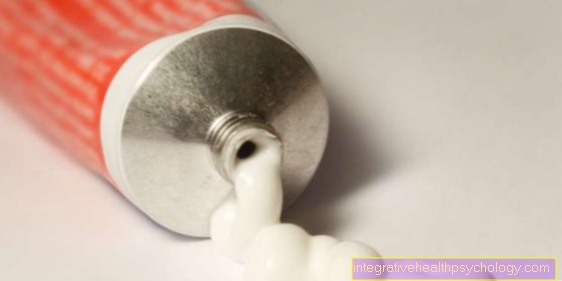Ventilation tubes
definition
A drum tube is a tube inserted into the eardrum that creates a connection from the external auditory canal to the middle ear. Figuratively speaking, it ensures that there is a hole in the eardrum for a certain period of time. Depending on the requirements, it can consist of a wide variety of materials such as silicone or titanium.
The therapy goal of the ear tube is to allow secretions to drain from the middle ear and thus to ensure good ventilation of the tympanic cavity. The healing of inflammatory or injury-related processes in the area of the middle ear is thus promoted.
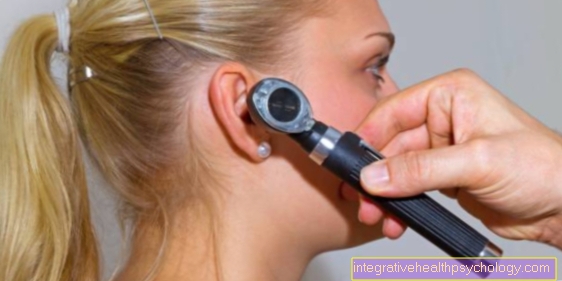
When do I need a ventilation tube?
Any accumulation of secretion in the middle ear can be an indication for a ventilation tube. Most often this occurs in the context of an otitis media. The decision to bring in depends primarily on the amount of accumulated liquid and less on the type of secretion. During the medical examination, this can be determined by looking at the eardrum. The more secretion has accumulated in the middle ear, the more the eardrum deflects in the direction of the examiner. An outwardly curved eardrum indicates that the pressure in the middle ear is too high, which may have to be relieved using a tympanic tube.
Another clue for the examiner is the "hammer grip" located in the middle of the eardrum as part of the ossicles. If the fluid level exceeds this anatomical structure, then the indication for a ventilation tube should be considered in connection with the symptoms of the person concerned.
Since the eardrum is also parchment-like, both the structures behind it and the nature of the secretion can be guessed at. Yellow-whitish secretion speaks for inflammatory processes with pus formation and reddish secretion for a bloody accumulation of fluid. These two secretion colors sometimes also speak in favor of a ventilation tube, as inflammation can spread towards the inner ear and blood could stick the ossicles together. Here, however, an accurate assessment of an ENT doctor is required.
Read more about the topic here: Otitis media
How does the operation work?
In and of itself, the insertion of a ventilation tube is not a real operation, but rather an outpatient procedure. It only takes a few minutes and usually does not require any further hospitalization. However, the procedure itself injures the eardrum, so that an explanation of the course and the possible risks is necessary. This gives this small intervention its surgical character.
In order to make the use of the ear tube as comfortable as possible for the affected person, an anesthetic of the eardrum is necessary. This can be done locally by applying an anesthetic to the eardrum in the form of a solution or by administering a pain reliever in the form of an infusion. If the person concerned decides in favor of local anesthesia, he is awake during the entire procedure and can in principle go home immediately afterwards or receive further treatment.
If general anesthesia is considered, this is usually due to the planned further treatment of the middle ear during the procedure. If irrigation or further rehabilitation of the middle ear is necessary, general anesthesia is necessary for a short time. Fear or excitement play an important role in children’s decision to use general anesthesia.
If the eardrum is numbed, it is opened with a small slit in the anterior lower quadrant using a scalpel. The ear tube is then inserted into this slot. No further fastening is required, as the damage to the eardrum causes it to stick to the little blood that has been released and thus finds a natural hold. Once the ear tube has been inserted, the procedure is already over and the person affected still needs to be observed briefly. After a general anesthetic, a short inpatient stay should be considered in individual cases.
Aftercare
Follow-up treatment requires further therapy for the triggering cause.
Usually an otitis media was the indication for a ventilation tube. Adequate therapy using antipyretic agents, painkillers and antibiotics is an important component of the follow-up treatment here, in addition to regular monitoring of the position of the ventilation tube. In the case of acute illness, this means that the doctor has to call the person affected every few days so that the medication can be adjusted if necessary and the discharge of the secretion through the ventilation tube can be guaranteed.
Once the disease has been overcome, the ventilation tube is left in most cases. It is actually repelled by the body itself and guarantees a completed healing process. With the renewal of the eardrum in the injured area, the tympanic tube is pushed forward piece by piece in the direction of the external auditory canal. As the tissue defect is covered, it falls into the external auditory canal and is often unconsciously lost because of its small size.
The restored eardrum therefore speaks for a healed process, as it can only grow together completely in the absence of pathogens or secretions. On the other hand, there would be too much tension on the eardrum due to accumulated fluid, so that its wound edges would not be able to close. Therefore, you wait a few weeks for the natural healing process.
A follow-up check at a generous interval is therefore justified after the acute treatment by the resident doctor.
Read more about the topic here: Foreign body in the ear
How long does the ear tube have to stay?
It depends entirely on the degree of the disease how long the ventilation tube has to stay in the eardrum.
In the case of an acute illness, it should be left on until it has completely healed. If there are chronic complaints, it may be necessary to stay for up to twelve months.
If it is brought in because of an acute otitis media, it is usually rejected by the body itself within a few days to a maximum of two weeks. During this time, those affected also suffer from a feeling of illness, so that the tympanic tube is still entitled to remain in place even if there is a significant improvement and further supports the further healing.
How is the ear tube removed?
In most cases, the body removes the ventilation tube itself. As the natural healing process progresses, new tissue pushes it towards the external ear canal. This can be explained figuratively by its natural shape. It resembles a funnel, the narrowing of which points towards the middle ear. The ear tube is located in the anterior lower quadrant and therefore has its main weight in the direction of the external auditory canal by means of gravity. If the defect in the eardrum is closed and the material of the tympanic tube recognized as foreign is rejected, it falls outwards and not in the direction of the middle ear.
If this process does not take place, the tube can also be removed manually by the doctor. This is especially the case with T-shaped ventilation tubes as part of long-term therapy. By pulling on the tube, the carriers fold up behind the eardrum and the tube can be easily removed.
What is the maximum length of time you can wear a ventilation tube?
The length of time a ventilation tube stays in place is determined by its shape and the choice of material.
A long dwell time is guaranteed above all by a T-shape. The roof of the T lies behind the eardrum and prevents the material from being repelled by the healing process. The choice of silicone as a material also promises good compatibility, so that the eardrum is influenced as little as possible by the foreign body introduced. If these factors ensure an optimal fit and good tissue tolerance, a ventilation tube can remain in place for up to a year or more. However, the tube should be checked regularly for permeability.
What are the risks?
The installation of a ventilation tube is a relatively low-risk form of treatment. The greatest risk is the incorrect insertion of the ear tube into the eardrum. It is important that it is used in the lower front quadrant. Placing it in a different quadrant could damage the ossicular structures behind it. The injury can then manifest itself in a reduced hearing ability.
Bleeding is unlikely during the procedure. The eardrum is a part of the ear that has blood supply, but it does not carry large vessels. The surrounding structures are also largely bony or cartilaginous in nature and do not harbor the risk of a major source of bleeding.
The fear of a too large cut in the eardrum is quite justified. A cut that is too large can mean that the ear tube can no longer be securely anchored in the artificially created hole. Here, however, the person concerned can be reassured that the eardrum has a good ability to regenerate. Usually it heals within a few weeks and the goal of acute relief of the middle ear was achieved anyway. In addition, every medical incision is usually smaller than a natural tear in the eardrum.
A rupture of the eardrum occurs naturally when the accumulation of secretions puts too much pressure on the eardrum. The installation of a ventilation tube anticipates this and minimizes the defect. In the optimal case, the diameter of the tube is therefore around one millimeter.
You can find more information on the topic here: eardrum
How bad is the pain afterwards?
If pain occurs in connection with the placement of a ventilation tube, it is usually not caused by the ventilation tube itself. Rather, it is the circumstance, such as an otitis media, that leads to the pain. The process of emptying accumulated secretions from the middle ear through the tube can be painful at first, as the flow of secretions irritates the inflamed mucous membrane in the middle ear.
Experience shows, however, that those affected feel less pain after insertion, as the pressure from the tense eardrum is relieved.
What can you do about it?
It depends on the intensity of the pain which pain reliever should be chosen.
In the case of mild pain, moving the head can often help to bring about an improvement. Here the person concerned has to decide individually whether lying on the side or sitting upright helps better. If this simple measure is not enough, we recommend a pain reliever with an anti-inflammatory component such as Ibuprofen to take. The dosage should be based on age and according to the package insert. If the pain persists, a doctor should always be consulted.

What to do if the ventilation tube is blocked
If the ventilation tube is blocked, there are two alternatives to solve the problem
- In some cases, the obstruction can be cleared by the ENT doctor without removing the ventilation tube. In the majority of cases it is light encrustations from dried-on secretion or ear wax that obstruct the opening of the tube. A slight detachment can help in these cases.
- If it is not possible to restore patency, the ventilation tube must be changed.
This process is much easier than the initial application of the ear tube. For this, the eardrum is usually anesthetized locally and the clogged tube is removed. It is replaced by a new tube that is inserted in the same place.
To prevent re-clogging, it may sometimes be necessary to choose a tube with a different diameter or a different material. Small particles in the secretion can no longer clog the lumen or stick to the material.
Ventilation tubes made of gold-platinum are particularly suitable here, as they have an additional antibacterial effect. Any swelling around the opening is thus prevented and enables the secretion to be emptied properly. However, ear tubes made of silicone are just as good at transferring secretions and are recommended because of their easy malleability to the tissue.
Why does secretion run out of the ear?
The purpose of the ear tube is to create a connection between the external auditory canal and the middle ear. This should ensure the ventilation of the middle ear and the drainage of accumulated secretion. So if the ear rests after inserting a ventilation tube, this speaks for a successful therapy.
The secretion is passed out through the tube and shows up in a discharge from the ear. Depending on the type of secretion, it can take on a clear to yellowish color and its smell can vary greatly.
As a rule of thumb, a gradual reduction in the discharge over days should apply. With the emptied secretion, the pathogens should also be eliminated from the middle ear. An increasing discharge indicates a complicated healing process and should be clarified by a doctor.
In general, the discharge should be intercepted with cotton in the outer ear canal. Loosely inserted into the ear canal, the cotton absorbs the secretion and can then be easily removed. Changing them regularly is very important here, as otherwise the infection may rise again. This may be necessary every four hours at the beginning of therapy.
Those affected should not be alarmed by the amount of discharge, but rather support smooth emptying. This can be achieved by lying additionally on the affected side.
Can I swim with a ventilation tube?
Swimming with a ventilation tube is not recommended.
Usually the water is held up by the eardrum. With a ventilation tube, it can pass through the eardrum and enter the middle ear, as does secretion from the middle ear into the external auditory canal. When swimming, the sterile area of the middle ear can come into contact with pathogens that could infect both the ossicles and the adjacent inner ear.
In addition, the middle ear is otherwise only filled with air. So water could also cause physical damage in this area and influence the ability of the structures to vibrate. Using earplugs is one solution to swimming with a ventilation tube. In this case, however, the optimal fit must be guaranteed by a hearing aid acoustician.
Read more about the topic here: Water in the ear
What kind of water protection is there?
The use of a water protection is absolutely necessary with an inserted ear tube. Which water protection should be used, however, depends on the humidity and the extent of the wetting with water.
- For being outdoors, it is usually sufficient to use cotton wool in the outer ear canal, which should be changed regularly.
- When showering, cotton wool is sufficient even if the shower head is used carefully. However, those who cannot guarantee entry of water should use ear plugs.Commercially available earplugs from the pharmacy are sufficient for showering.
- However, if you want to swim with a ventilation tube, you should have it adjusted by a hearing care professional to ensure an optimal fit.
Can you fly with a ventilation tube?
Affected people can safely fly in an airplane with a ventilation tube. The pressure equalization can take place just as well via the ear drum as via the deflection of the eardrum. The only difference in a lying ear drum is that the eardrum does not deflect, if at all, because the air can freely pass through the eardrum. From a purely objective point of view, equalizing the pressure during take-off and landing is even easier and more pleasant for those affected, as the well-innervated eardrum is not irritated and there is no feeling of pressure.
Can you do an MRI with a ventilation tube?
It has to be decided on a case-by-case basis whether an MRI can be done with a lying ventilation tube without any problems. The manufacturer of the implant should be consulted for precise information. In general, however, it mainly depends on the material of the ear tube whether the magnetic field that has built up is disturbed during the examination.
As a rule of thumb, ventilation tubes with silicone are generally safe for an MRI and tubes containing metal require further agreement.
In any case, the person concerned must always truthfully state the presence of a ventilation tube so that the examination does not cause any damage.
The peculiarities of the ventilation tube in adults
The real peculiarity of the adult ventilation tube is that it is required less often. The greatest risk of otitis media with an accumulation of secretions can be found in childhood. Adults are less likely to have this condition. However, should a ventilation tube be necessary, the procedure and handling is exactly the same as for children. However, the procedure is almost always carried out on an outpatient basis under local anesthesia, while in small children it is more likely to be carried out under general anesthesia.
Regarding everyday life with the ventilation tube, it should be said that adults may be exposed to other circumstances than children. In concrete terms, this means, for example, in the event of noise exposure at the workplace, adequate hearing protection should be provided with the ventilation tube lying down.
In contrast to children, the few adults also have more chronic courses that require long-term therapy. It is not uncommon for the ventilation tube to remain in place for up to a year. Here it is important to exclude other factors as possible causes and, if necessary, to treat them as well. In adults, for example, the paranasal sinuses and the mouth and throat area must be examined as possible triggers.
How much does it cost to insert a ventilation tube?
Statutory health insurance pays the costs for inserting a ventilation tube. However, after the procedure, depending on the health insurance company, additional costs may arise for adapted earplugs, which may be required for showering or swimming. Here it is necessary to contact your own health insurance company and clarify whether part or all of the costs will be covered.
What are the alternatives to the ventilation tube?
The alternative to the ear tube is the natural rupture of the eardrum due to the accumulation of secretion. If the pressure on the eardrum due to the accumulated fluid in the middle ear becomes too great, the tissue tears as a result of the overload. The effect is the same as with a ventilation tube. A hole is created in the eardrum and the secretion can drain through the external auditory canal.
In contrast to the installation of a ventilation tube, this happens later. Those affected often suffer from earache and possibly a throbbing feeling in the ear for longer. However, if the pressure has been equalized, the sensation is to be equated with that after the use of a ventilation tube.
The further healing process differs, however. A torn eardrum does not contain any foreign body and can heal completely immediately after the secretion has drained. The crack is closed again within a few days to a few weeks. The edges of the wound stick together relatively quickly and form a flat eardrum. With a ventilation tube, the opening remains longer because the tissue has to repel the foreign material.
The alternative to the ear tube is the body's own way of dealing with the accumulation of secretion in the middle ear. There is no right or wrong in this regard. It can only alleviate symptoms and shorten the course of the disease somewhat. The natural tearing and healing of the eardrum is not a disadvantage in the acute course of the disease.
Natural tearing should only be avoided in chronic processes.
This article might also interest you: Torn eardrum - You should do this

